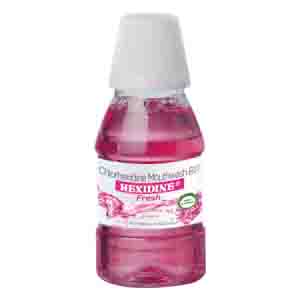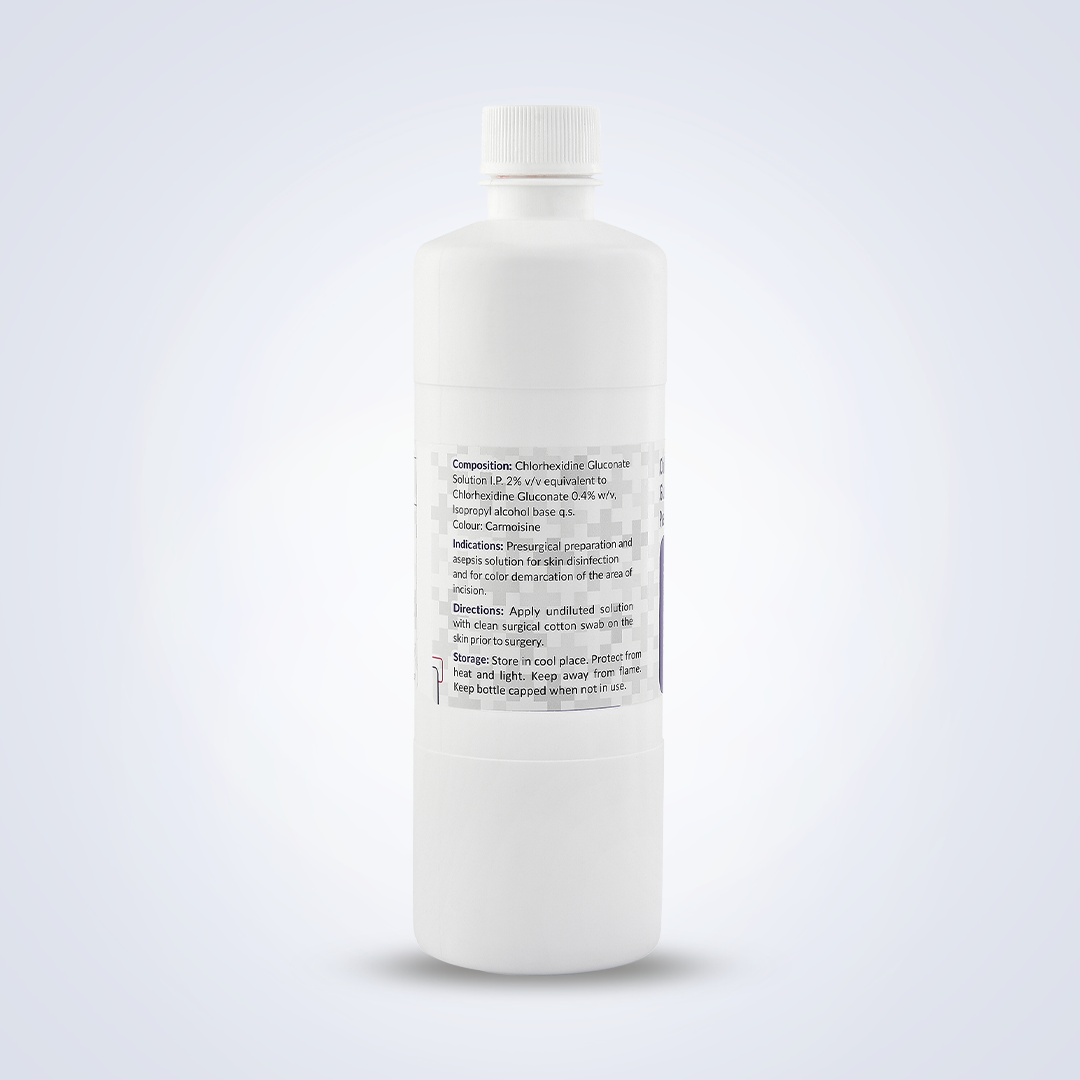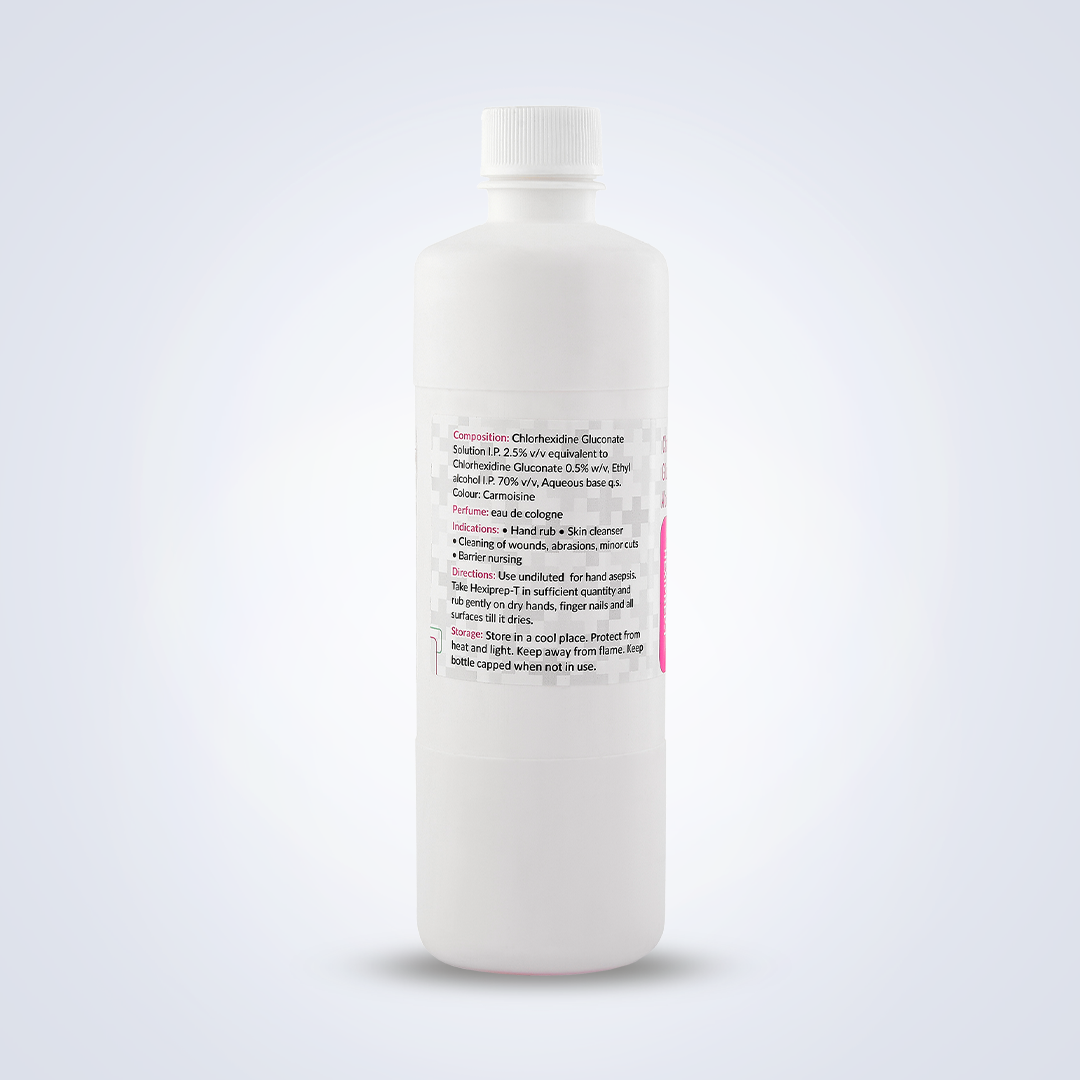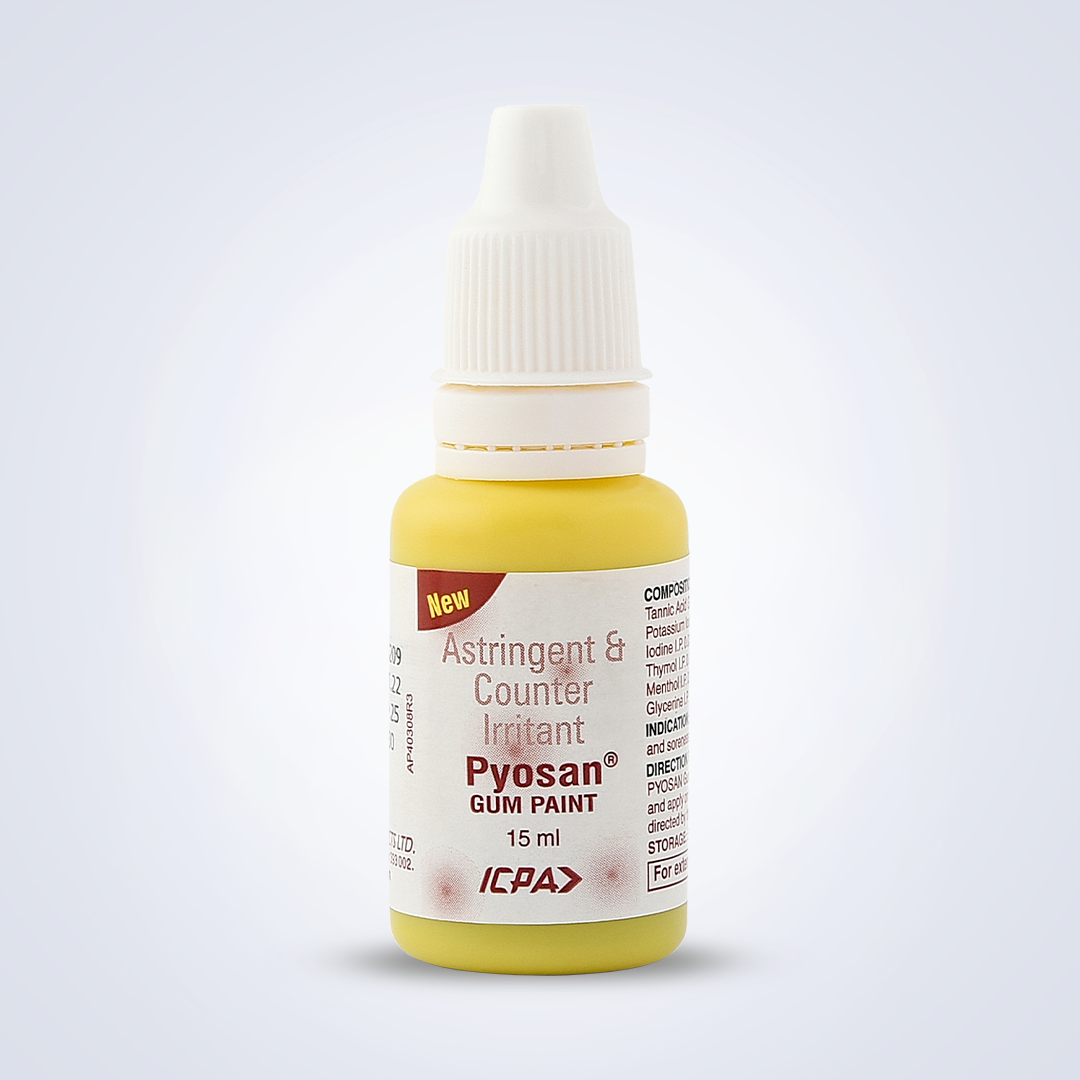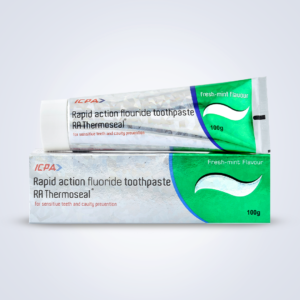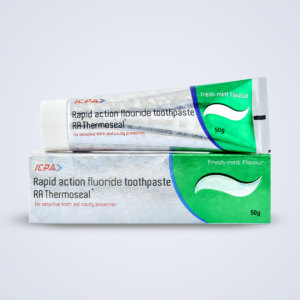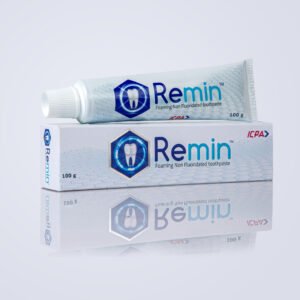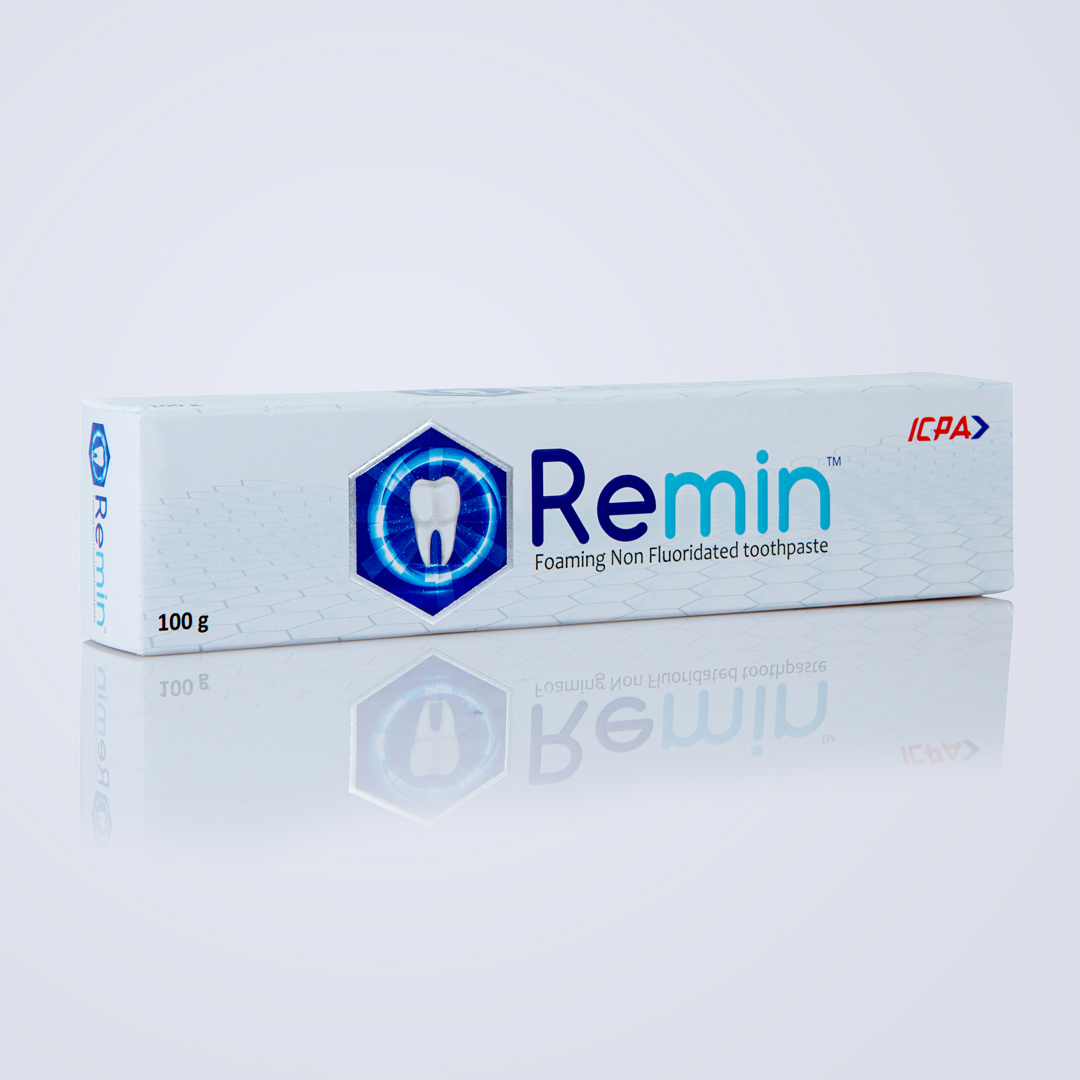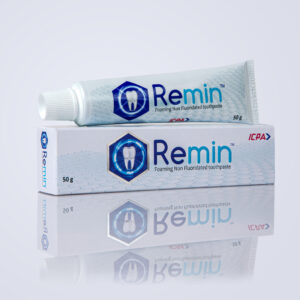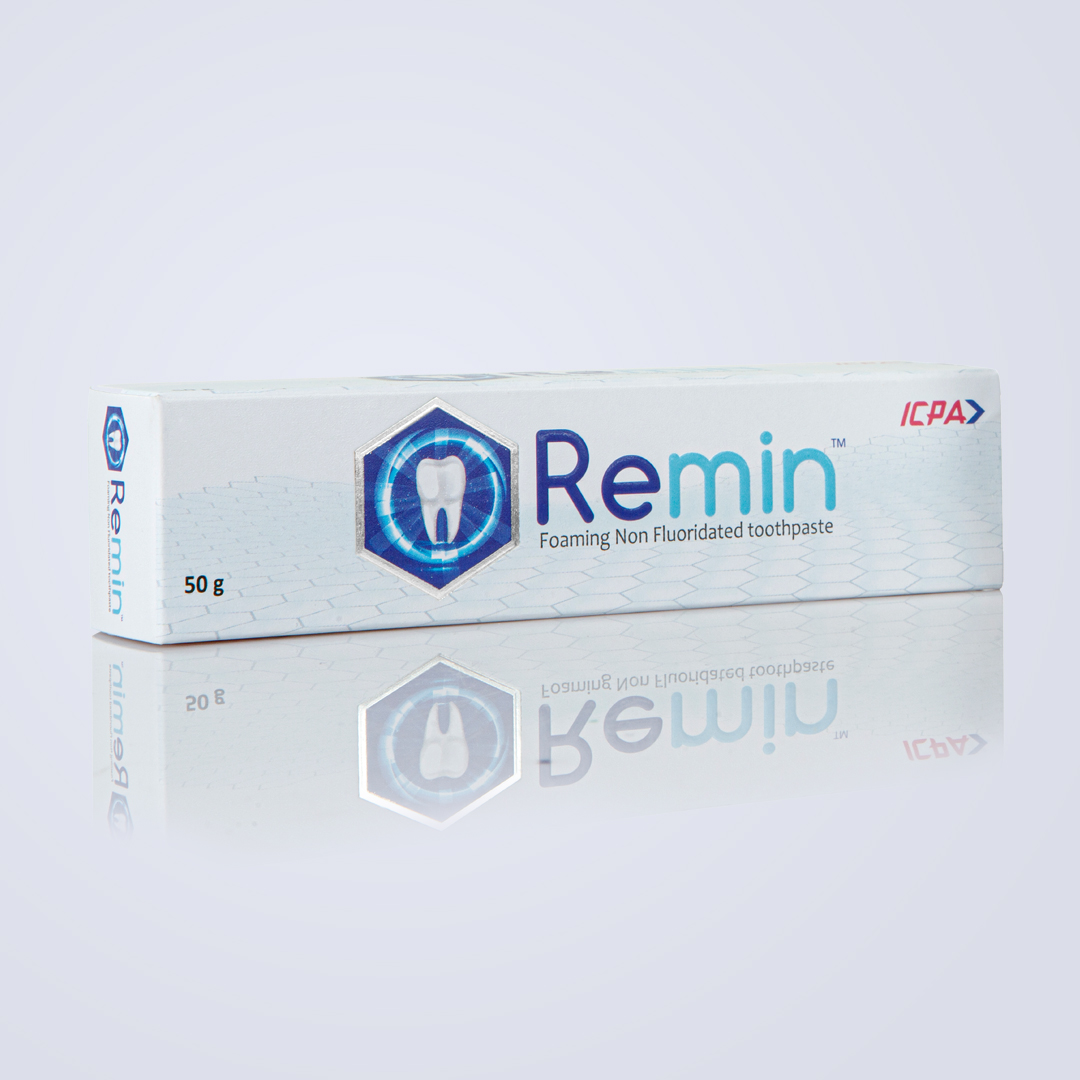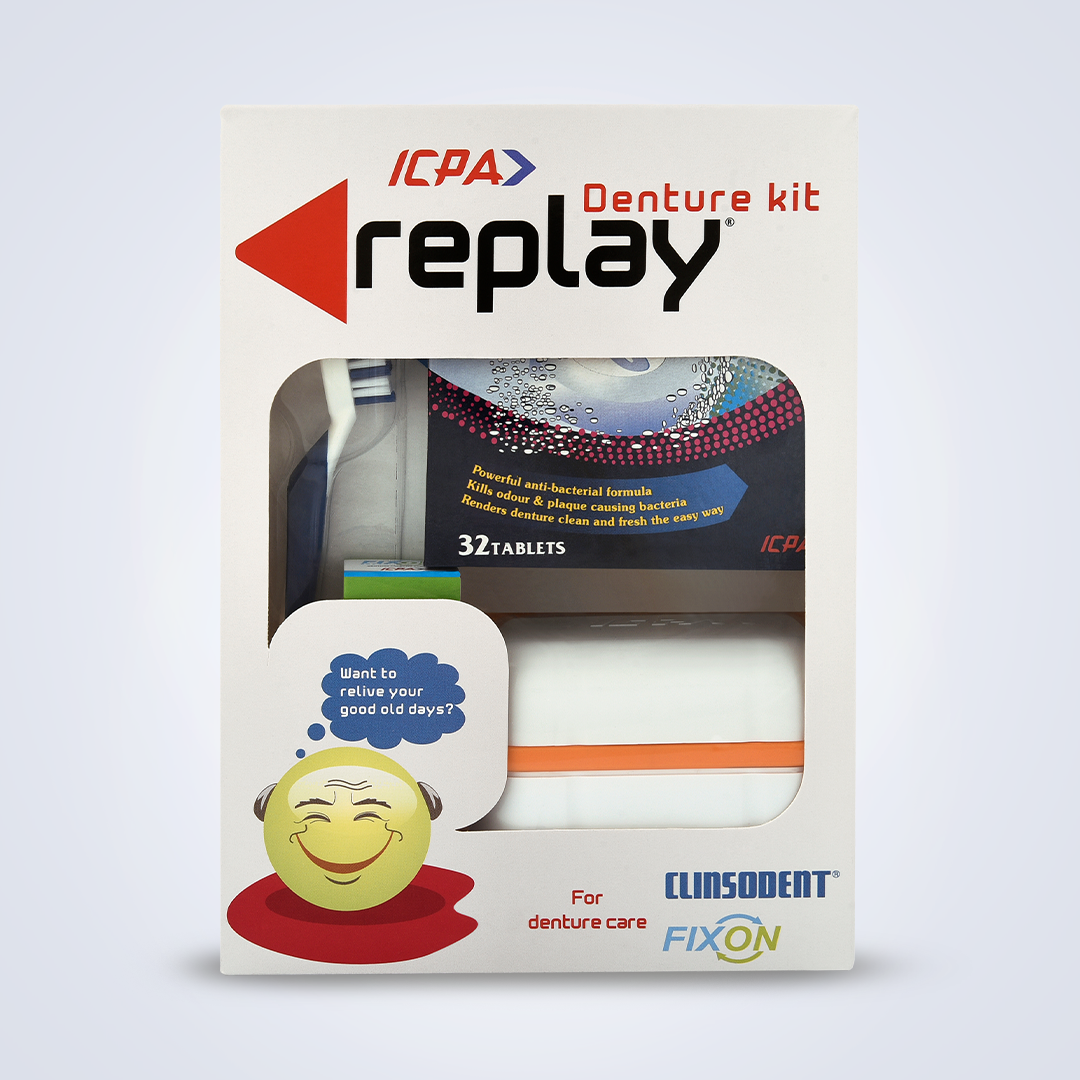Dental Products
Dental Products
Showing 13–24 of 42 results
-
Hexidine Fresh Anise 300m..
Read More Quick ViewHexidine Fresh 300 ml (Anise flavour)
Composition:
Chlorhexidine gluconate solution I.P. diluted to Chlorhexidine gluconate 0.2% w/v in a pleasantly flavoured base.Mode of action:
Bacterial plaque produces irritants, which cause gingivitis and periodontitis, ultimately leading to loss of teeth. Chemical control of plaque is achieved effectively with Hexidine Fresh 300ml. As an antimicrobial, Hexidine Fresh 300ml prevents secondary infections arising out of poor oral hygiene.It is particularly useful in effective plaque control for:
- Patients undergoing gum and implant surgeries
Hexidine Fresh 300ml begins its microbicidal effect in 15 seconds after contact and its bacteriostatic action lasts for 12 hours.
Indications:
For therapeutic use post gum surgeries and implant surgeriesDirections for use:
For treatment, swish in the mouth for one minute. Do not rinse your mouth, eat, drink thereafter for 20 minutes. No dilution required. Recommended only under professional guidance.Dose:
10 ml, twice a day for 15 days.Caution:
Not to be swallowed. For oral use only. Brown staining of the teeth may be reported while using the product in some cases. This usually disappears once the treatment is over, or may require scaling/polishing.Special instructions:
Do not use toothpastes immediately after rinsing with Hexidine Fresh 300ml, as it will diminish its effect. Use them first or at a different time of the day, and rinse your mouth thoroughly with water before using Hexidine Fresh 300ml. Avoid tannin containing food and drinks for at least one hour after using Hexidine Fresh 300ml. If symptoms persist, stop using, and consult your dentist. Noticeable change in taste, or burning sensation may occur in exceptional cases upon first use. This usually goes away as you continue to use the product.Presentation:
PET bottle of 300 ml (10.14 oz.) -
Hexiprep 500ml
Read More Quick ViewMicrobicidal Skin Prepping Solution
Composition:
Chlorhexidine Gluconate Solution 2% v/v, equivalent to Chlorhexidine Gluconate 0.4% w/v, in Isopropyl Alcohol base. (Formulation available – I.P. – Domestic, B.P. – Export)Mode of Action:
15 seconds contact microbicidal 12 hours skin binderIndications:
Presurgical preparation and asepsis solution for skin disinfection and for colour demarcation of the area of incision. 66Directions for use:
Apply undiluted solution with clean surgical cotton swab on the skin prior to surgery.Storage:
Protect from heat and light. Keep away from flame. Keep bottle capped when not in use.Caution:
Keep away from eyes and children. For external use only.Presentation:
Plastic bottle of 500ml (16.9 fl.oz). -
Hexiprep T 500ml
Read More Quick ViewMicrobicidal Hand Rub
Composition:
Chlorhexidine Gluconate Solution 2.5% v/v, equivalent to Chlorhexidine Gluconate 0.5% w/v in aqueous base. Ethyl Alcohol 70% v/v Perfume: eau de Cologne (Formulation available – I.P. – Domestic, B.P. – Export)
Mode of Action:
15 seconds contact microbicidal 12 hours skin binder.
Indications:
Hand Rub Skin Cleanser Cleaning of wounds, abrasions, minor cuts Barrier Nursing.
Directions for use:
Use undiluted for hand asepsis. Take Hexiprep-T in sufficient quantity and rub gently on dry hands, fingernails, and all surfaces, till it dries.
Storage:
Protect from heat and light. Keep away from flame Keep bottle capped when not in use.
Caution:
Keep away from eyes and children For external use only.
Presentation:
Plastic bottle of 500ml (16.9 fl. oz), with a pump
-
ICPAMOX-CV
Read More Quick ViewComposition:
Amoxycillin 500mg + Clavulanic acid 125mg Tablet
Introduction:
ICPAMOX-CV 625 is an antibiotic with broad-spectrum activity against the commonly occurring bacterial pathogens involved in the infections of the oral cavity and other parts of the body. The beta-lactamase inhibitory action of clavulanic acid extends the spectrum of Amoxycillin to act against a wider range of organisms, including many resistant to other beta-lactam antibiotics.
Indications:
ICPAMOX-CV improves treatment success rate in,
1. Acute periapical abscess; along with endo treatment
2. Before starting endo treatment; to reduce post-operative pain
3. Tooth extraction & other oral surgeries; to reduce post-operative infection and bacteremia
4. Before wisdom tooth surgeries; to prevent post-operative infection & dry socket
5. Pericoronitis & Peri-implantitis
6. Periodontitis (as an adjunct to scaling & root planing), periodontal surgeries, periodontal abscess.
7. Facial cellulitisDose:
One tablet BID for 3-7 Days.
Presentation:
Alu Alu blister pack of 10 tablets
Common side effects:
- Diarrhea
- Stomach upset
- Nausea and vomiting
- Mild skin rash
-
Icparil Tab 10’s
Read More Quick ViewComposition:
Each uncoated tablet contains: Paracetamol 325mg Aceclofenac 100mgMode of Action:
Aceclofenac relieves pain and inflammation through a variety of mechanisms and in addition exerts stimulatory effects on cartilage matrix synthesis.
Paracetamol is a clinically proven analgesic and antipyretic agent with weak inflammatory effect. Paracetamol produces analgesia by raising pain threshold. And inhibits COX in CNS and exerts antipyretic action.Indications:
All inflammatory & painful conditions Pre & Post – extraction of teeth Rheumatoid arthritis Spondylitis Osteoarthritis Low back pain Periarthritis of shoulders Other musculoskeletal and joint disorders such as sprains & strains Pelvic inflammation Post – operative pain DysmenorrheaCaution:
Paracetamol overdose may cause liver failure.Dose:
One tablet twice a day or as directed by the physician.Presentation:
Blister pack of 10 Tablets. -
PulpCAL
Read More Quick ViewRadiopaque Calcium Hydroxide Composition
Radiopaque Calcium Hydroxide Composition is a rigid, self-setting material useful in pulp-capping, and as a protective base/liner under dental filling materials. It will not inhibit the polymerization of acrylic and composite restorations. Calcium hydroxide paste encourages repair of active calcification and acts as a protection to external stimuli. Promotes re-calcification of minerals and high pH of paste has an antimicrobial effect against growth of harmful pathogens.
Composition:
Base Paste: 1, 3 butylene glycol disalicylate, calcium phosphate, barium sulphate, zinc oxide, iron oxide, calcium sulphate and titanium dioxide.
Catalyst Paste: calcium hydroxide, ethyl toluenesulphonate, zinc stearate, titanium dioxide, and zinc oxide.
Usage:
1. Applicable to exposed vital pulp tissue.
2. Application to dentine as protective barrier between restorative barrier between materials and deep vital dentine (indirect pulp capping) or where dentine to restorative material contact is not desired.
3. Direct pulp capping.
Warning:
Avoid prolonged or repeated exposure of liner material with skin, oral soft tissue, and eyes. Irritation and possible corneal damage may result. Skin rash, oral mucosa, or other allergic reactions may result in susceptible individuals. Do not take internally.
Direction of use:
1. Direct Pulp capping: Dispense equal volumes of base and catalyst paste (1.17:1 by weight) on parchment paper pad provided. Replace container caps. Using a liner applicator, stir immediately to mix thoroughly until a homogenously uniform mixer is observed. Complete mixing within 10 seconds.
Using a ball pointed calcium hydroxide liner applicator or similar instrument, place the mix directly on exposed dental pulp and cavity dentine judged to be less than 1.0mm remaining thickness in a thin layer. Avoid placing a liner on enamel or margins of cavity. Allow the liner to set completely. The mixed material will set in approximately 2-3 minutes on the mixing pad under normal room conditions. Set time is shorter in mouth due to moisture and temperature.
2. In direct Pulp capping, Protective barrier; under suitable isolation, complete cavity preparation and caries removal. Wash the cavity thoroughly with water spray and air dry. Disperse and mix liner components as outlined above.
Apply mixed material to desired dentine surfaces as outlined above.
Pack size:
Base Paste – 13 gm
Catalyst paste – 11 gm
-
Pyosan Gum Paint 15ml
Read More Quick ViewComposition:
Tannic Acid 72%: Astringent
Glycerine 27%: Base for tannic acid
Iodine I.P. 0.03%: Counter-irritant and disinfectant
Potassium iodide I.P. 0.05%: Stabilizer for iodine
Menthol I.P. 0.05%: Mild anaesthetic and Rubifacient
Thymol I.P. 0.033%: Disinfectant and RubifacientCounterirritants and rubefacients
Counterirritants and rubefacients are substances used in periodontology and dentistry to alleviate pain and discomfort associated with oral conditions. They work by producing localized irritation or a sensation of heat on the skin or mucous membranes, which can help distract from or relieve pain.
Counterirritants:
Counterirritants are substances or agents that are applied topically to the skin or mucous membranes in the oral cavity. These substances create a mild irritation, which draws blood and immune system responses to the affected area, effectively diverting attention away from the original source of pain or discomfort. In periodontology, counterirritants may be used to alleviate pain associated with conditions like gingivitis, periodontitis, or oral ulcers.
Rubefacients:
Rubefacients are substances that produce a localized increase in blood flow and redness of the skin or mucous membranes when applied. In the context ofperiodontology, rubefacients may be used to increase blood flow to an area, which can help reduce inflammation and alleviate pain.
Mode of action:
Bleeding gums & pus discharge are a sign of poor oral hygiene and have to be treated symptomatically by a dentist. Astringents help to stop the bleeding & pus discharge of gums, by coagulating proteins. Iodine & Menthol will act as counterirritant & rubefacient and provide relief from itching & irritation. Menthol will additionally provide comfort to the patient.
Indication:
Inflamed sore gums/spongy gums
Directions for use:
Take Pyosan gum paint on the fingertip and apply on the affected gum.
Storage:
Store in cool, dark place.
Caution:
For external use only.
Presentation:
Plastic bottle of 15ml (0.5 fl. oz) with inbuilt dropper.
-
RA Thermoseal 100gm
Read More Quick ViewToothpaste for Dental Hypersensitivity
Composition:
Potassium Nitrate 5% w/w in toothpaste/gel base. Sodium monofluorophosphate 0.7% w/w (available fluoride content 917 ppm when packed).Mode of Action:
Dentinal hypersensitivity is a sharp pain produced in the teeth-, in response to stimuli, such as cold, heat, sweet, sour, or contact. It affects the quality of life and results in extreme discomfort or inability to eat or drink certain foods. It is caused due to opening of the dentinal tubules, after the enamel has been removed by factors such as attrition, abrasion, erosion, or gum recession. RA Thermoseal provides relief from dentinal pain by forming a neurosensory block. Fluoride provides cavity protection. It reduces the demineralization of enamel and dentin by decreasing the acid production of bacterial plaque and decreases the solubility of apatite crystals. It readily becomes incorporated as fluoroapatite layer, to reduce the dissolution of apatite during acid attacks.Indication:
Dentinal hypersensitivity.Directions:
Adults and children over 12 years of age should apply at least 2.5 cm (1”) strip of the product to a soft bristle toothbrush. Brush teeth to clean all surfaces thoroughly with RA Thermoseal toothpaste/gel at least twice a day (morning and evening), or as recommended by a dentist or doctor. Make sure to brush sensitive areas for a longer time.Uses:
- Builds increasing protection against sensitivity of teeth to cold, heat, acids, sweets or contact.
- Helps in the prevention of dental cavities.
Warnings:
For usage beyond 4 weeks, please consult a dentist or doctor. Keep out of reach of children under 6 years of age. Stop use and ask a dentist if the problem persists or worsens.Presentation:
Lamitube of 50g (1.76 oz) / 100g (3.52 oz), Gel in lamitube of 100g (3.52 oz). -
RA Thermoseal 50gm
Read More Quick ViewComposition:
Potassium Nitrate 5% w/w in toothpaste/gel base. Sodium monofluorophosphate 0.7% w/w (available fluoride content 917 ppm when packed).
Understanding the tooth structure:
For an effective management of dentinal hyprsensitivity, it is essential to understand the tooth structure and the roles of enamel, dentin, and pulp, as well as how they contribute to or are affected by tooth sensitivity.
1. Enamel:
a. Enamel is the outermost layer of the tooth, and it is the hardest and most mineralized tissue in the human body.
b. Enamel serves as a protective shield for the more sensitive inner layers of the tooth, primarily dentin and pulp.
c. It is a non-living tissue and is devoid of nerve endings, which means it does not transmit pain or sensations.2. Dentin:
a. Dentin is located beneath the enamel and makes up the bulk of the tooth structure.
b. It is a living tissue, containing microscopic tubules that extend from the outer surface of the dentin (adjacent to the enamel or cementum) to the pulp chamber in the center of the tooth.
c. These dentinal tubules house nerve endings and fluid-filled channels, connecting to the dental pulp.
d. Dentin is responsible for transmitting sensations or pain to the pulp when it is stimulated by external factors.3. Pulp:
a. The pulp is the innermost portion of the tooth, residing in the pulp chamber and extending into the root canals.
b. It contains vital components like blood vessels, nerves, and connective tissues.
c. The pulp is responsible for nourishing and maintaining the tooth, as well as detecting and responding to external stimuli.
d. When dentin is exposed or irritated due to factors like enamel erosion, gum recession, or tooth decay, the pulp may transmit pain signals, causing tooth sensitivity.In relation to tooth hypersensitivity:
- Enamel erosion or loss can expose the underlying dentin to external stimuli, which can lead to hypersensitivity. Enamel acts as a protective barrier, and when it is compromised, it can no longer shield the dentin from temperature changes, acidic foods, or pressure.
- Dentin, with its tubules and nerve endings, is the primary culprit in tooth sensitivity. When the dentinal tubules are open or exposed, they can transmit sensations and pain to the pulp, causing discomfort or sharp pain.
- The pulp is the nerve center of the tooth, and it plays a crucial role in sensing and responding to external stimuli. When it receives signals from the dentin due to hypersensitivity, it may trigger pain responses, leading to the discomfort associated with sensitive teeth.
In summary, enamel protects the inner tooth structures, dentin contains the nerve endings responsible for tooth sensitivity, and the pulp is the central nervous system of the tooth that responds to external stimuli. Understanding the roles of these tooth structures is important in managing and addressing hypersensitivity.
Dentinal hypersensitivity (Sensitive teeth)
Dentinal hypersensitivity, also known as tooth sensitivity or sensitive teeth, is a common dental condition where an individual experiences short sharp pain arising from exposed dentin in response to stimuli, typically thermal, evaporative, tactile, osmotic, or chemical, and which cannot be ascribed to any other form of dental defect or pathology. This discomfort typically originates from the dentin, which is the inner layer of the tooth, lying beneath the protective enamel and cementum.
Common triggers:
Dentin contains tiny tubules that connect to the nerve endings in the dental pulp, and when these tubules are exposed or stimulated, it can lead to tooth sensitivity. Common triggers for dentinal hypersensitivity include:
1. Hot or cold foods and beverages.
2. Sweet or sour foods.
3. Cold air or cold water exposure.
4. Brushing or flossing teeth.
5. Pressure from biting or chewing.Etiology:
There are several potential causes of dentinal hypersensitivity, including:
1. Tooth enamel erosion: Enamel is the outermost layer of the tooth, and if it wears away due to factors like acid erosion from acidic foods or beverages, tooth grinding (bruxism), or aggressive toothbrushing, it can expose the dentin.
2. Gum recession: When the gum tissue recedes, it exposes the tooth roots, which are not protected by enamel. The dentin on these exposed areas is more susceptible to sensitivity.
3. Tooth decay or cavities: If cavities form and progress to the dentin, it can cause sensitivity.
4. Cracked or chipped teeth: These can create pathways for stimuli to reach the dentin, causing sensitivity.Management of dentinal hypersensitivity:
To manage dentinal hypersensitivity, individuals can try various approaches, including:
1. Using desensitizing toothpaste: Special toothpaste formulations contain compounds like potassium nitrate or fluoride that can help block the tubules in the dentin, reducing sensitivity.
2. Avoiding acidic and abrasive foods: Minimizing consumption of acidic foods and drinks and using a soft-bristle toothbrush can help prevent further enamel erosion.
3. Good oral hygiene: Maintaining regular oral hygiene practices, such as proper brushing and flossing, can prevent the development of cavities and gum disease.
4. Dental treatments: In some cases, a dentist may recommend treatments like fluoride varnishes, bonding, or dental sealants to address sensitivity.It’s essential to consult a dentist if you experience persistent or severe dentinal hypersensitivity to determine the underlying cause and receive appropriate treatment. Your dentist can provide guidance on managing and addressing your specific condition.
Mode of Action:
RA Thermoseal provides relief from dentinal pain by forming a neurosensory block. Fluoride ensures tooth surface remineralization. It reduces the demineralization of enamel and dentin by decreasing the acid production of bacterial plaque and decreases the solubility of apatite crystals. It readily becomes incorporated as fluoroapatite layer, to reduce the dissolution of apatite during acid attacks.
Potassium Nitrate and Sodium Monofluorophosphate based toothpastes are recommended by the standard textbooks as the first line treatment for dentinal hypersensitivity.
Indications:
1. Patients complaining of sensitive teeth. (Dentinal hypersensitivity).
2. Post-scaling sensitivity.
3. In tooth whitening treatments. Patients can start RA Thermoseal 2 weeks before the tooth whitening appointment.Directions:
Adults and children over 12 years of age should apply at least 2.5 cm (1”) strip of the product to a soft or ultrasoft bristle toothbrush. Brush teeth to clean all surfaces thoroughly with RA Thermoseal toothpaste/gel at least twice a day (morning and evening), or as recommended by a dentist or doctor. Make sure to brush sensitive areas for a longer time.
Uses:
1. Builds increasing protection against sensitivity of teeth to cold, heat, acids, sweets or contact.
2. Helps in the prevention of dental cavities.Warnings:
For usage beyond 4 weeks, please consult a dentist or doctor. Keep out of reach of children under 6 years of age. Stop use and ask a dentist if the problem persists or worsens.
Presentation:
Lamitube of 50g (1.76 oz) / 100g (3.52 oz), Gel in lamitube of 100g (3.52 oz).
-
Remin 100gm
Read More Quick View1. Composition – Calcium sodium phosphosilicate 5%
2. Mode of Action – The reaction of Bioactive Glass particles begins when the material is subjected to an aqueous environment.
- Bioactive glass is made up of amorphous Calcium-sodium- phosphosilicate (CSPS).
- CSPS is highly reactive in aqueous environments, such as saliva in the oral cavity.
- The exposure to saliva leads to the release of Sodium ions from the bioactive glass.
- In saliva, sodium ions from the bioactive glass readily react with salivary hydrogen cations (H3O+) resulting in a localized, transient increase in pH.
- Increased pH leads to the release of calcium, phosphate, and silica ions forming a robust HA-like layer
3. Indications – To promote tooth surface remineralization (esp. White Spot Lesions) and prevent Tooth Surface Loss (demineralization) under acid attack.
- To promote enamel remineralization and reverse ongoing enamel demineralization caused by acidic diets and carious bacterial acids.
- For daily remineralization of dental white spot lesions (WSL) during orthodontic treatment.
- For daily remineralization of dental white spot lesions (WSL) in people prone to dental caries.
- To seal dentinal tubules on exposed dentine surfaces, creating a stable seal even under acid attack— to prevent and ensure long-term relief from dentinal hypersensitivity.
- Daily tooth surface remineralization before meals for patients with acid erosion (e.g., gastritis, reflux, GERD).
- To remineralize and strengthen the tooth surfaces before, during, and after tooth whitening procedures.
4. Directions
- Brush twice daily.
- Spit out and do not swallow.
- Close the cap after each use.
5. Uses – Foaming non-fluoridated toothpaste, for dental use only
6. Warning – storage below 30° c
7. Presentation- 50 g and 100 g -
Remin 50gm
Read More Quick View1. Composition – Calcium sodium phosphosilicate 5%
2. Mode of Action – The reaction of Bioactive Glass particles begins when the material is subjected to an aqueous environment.
- Bioactive glass is made up of amorphous Calcium-sodium- phosphosilicate (CSPS).
- CSPS is highly reactive in aqueous environments, such as saliva in the oral cavity.
- The exposure to saliva leads to the release of Sodium ions from the bioactive glass.
- In saliva, sodium ions from the bioactive glass readily react with salivary hydrogen cations (H3O+) resulting in a localized, transient increase in pH.
- Increased pH leads to the release of calcium, phosphate, and silica ions forming a robust HA-like layer
3. Indications – To promote tooth surface remineralization (esp. White Spot Lesions) and prevent Tooth Surface Loss (demineralization) under acid attack.
- To promote enamel remineralization and reverse ongoing enamel demineralization caused by acidic diets and carious bacterial acids.
- For daily remineralization of dental white spot lesions (WSL) during orthodontic treatment.
- For daily remineralization of dental white spot lesions (WSL) in people prone to dental caries.
- To seal dentinal tubules on exposed dentine surfaces, creating a stable seal even under acid attack— to prevent and ensure long-term relief from dentinal hypersensitivity.
- Daily tooth surface remineralization before meals for patients with acid erosion (e.g., gastritis, reflux, GERD).
- To remineralize and strengthen the tooth surfaces before, during, and after tooth whitening procedures.
4. Directions
- Brush twice daily.
- Spit out and do not swallow.
- Close the cap after each use.
5. Uses – Foaming non-fluoridated toothpaste, for dental use only
6. Warning – storage below 30° c
7. Presentation- 50 g and 100 g -
Replay Kit
Read More Quick ViewDenture Management Kit consisting of Denture Storewell, Clinsodent Tablets, Clinsodent Brush and Fixon Denture Adhesive Cream.
CLINSODENT® DENTURE BRUSH
Hygienically designed – No seams where dirt can get trapped.
2 types of nylon bristles designed to clean all surfaces and grooves.Contoured design – Maximises control of brushing. Ambidexterity – Works in right or left hand.
CLINSODENT® TABLETS
EFFERVESCENT DENTURE CLEANSING TABLETSFIXON CREAM
DENTURE ADHESIVE CREAM
Quick Links
Our Products
Information
Contact us
- 216-219, Adarsh Industrial Estate, Sahar Road, Chakala, Andheri (East), Mumbai - 400099
- Fax : 28216928
- +91 22 40065305 / 40065306 / 40065307
- info@icpahealth.com


Selected Icpa Products
Click on Add to cart to add this item in cart.
| PRODUCTS | QTY | PRICE | VALUE in INR |
|---|
Selected Icpa Products
Click on Add to cart to add this item in cart.
| PRODUCTS | QTY | PRICE | VALUE in INR |
|---|

